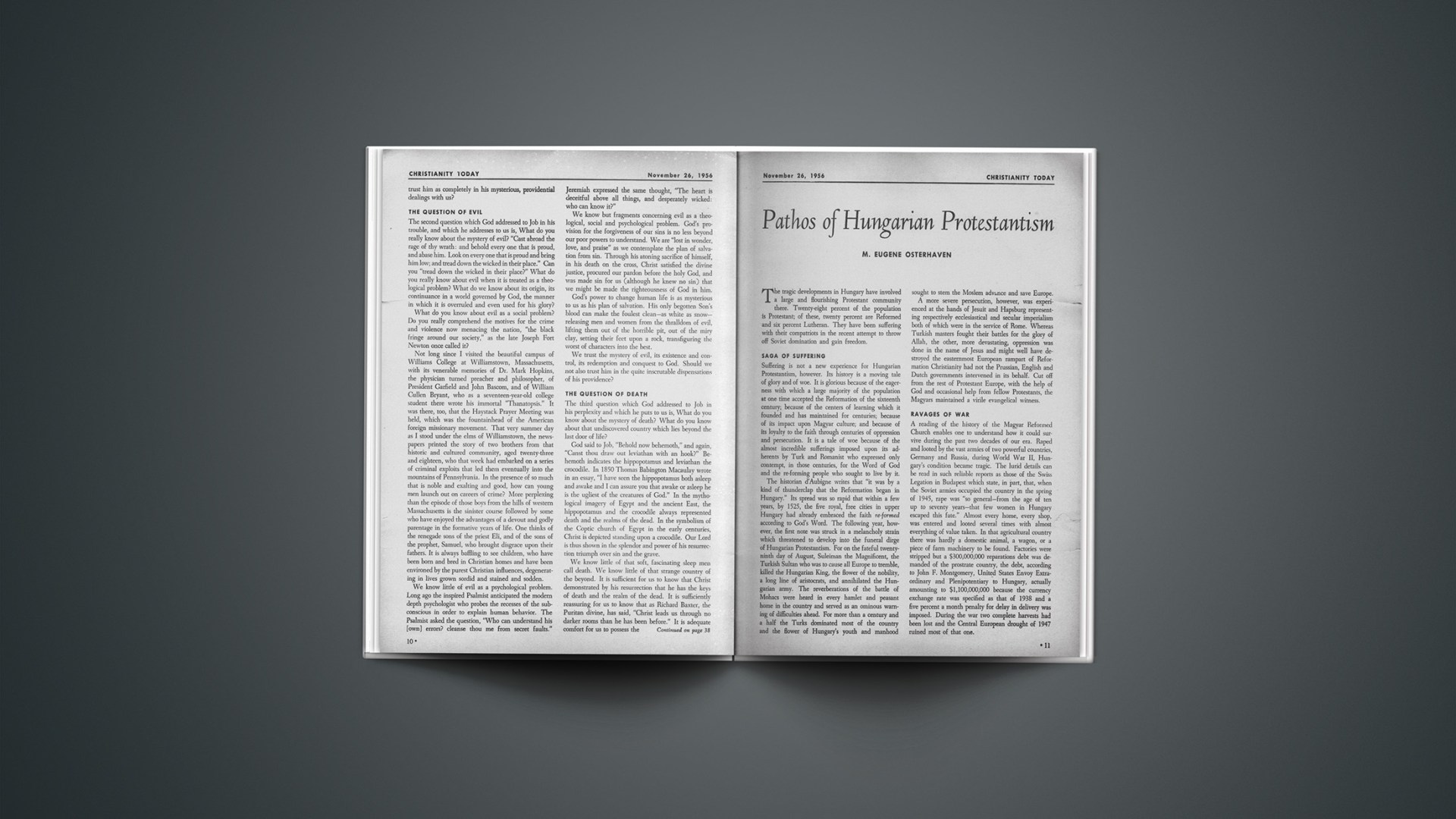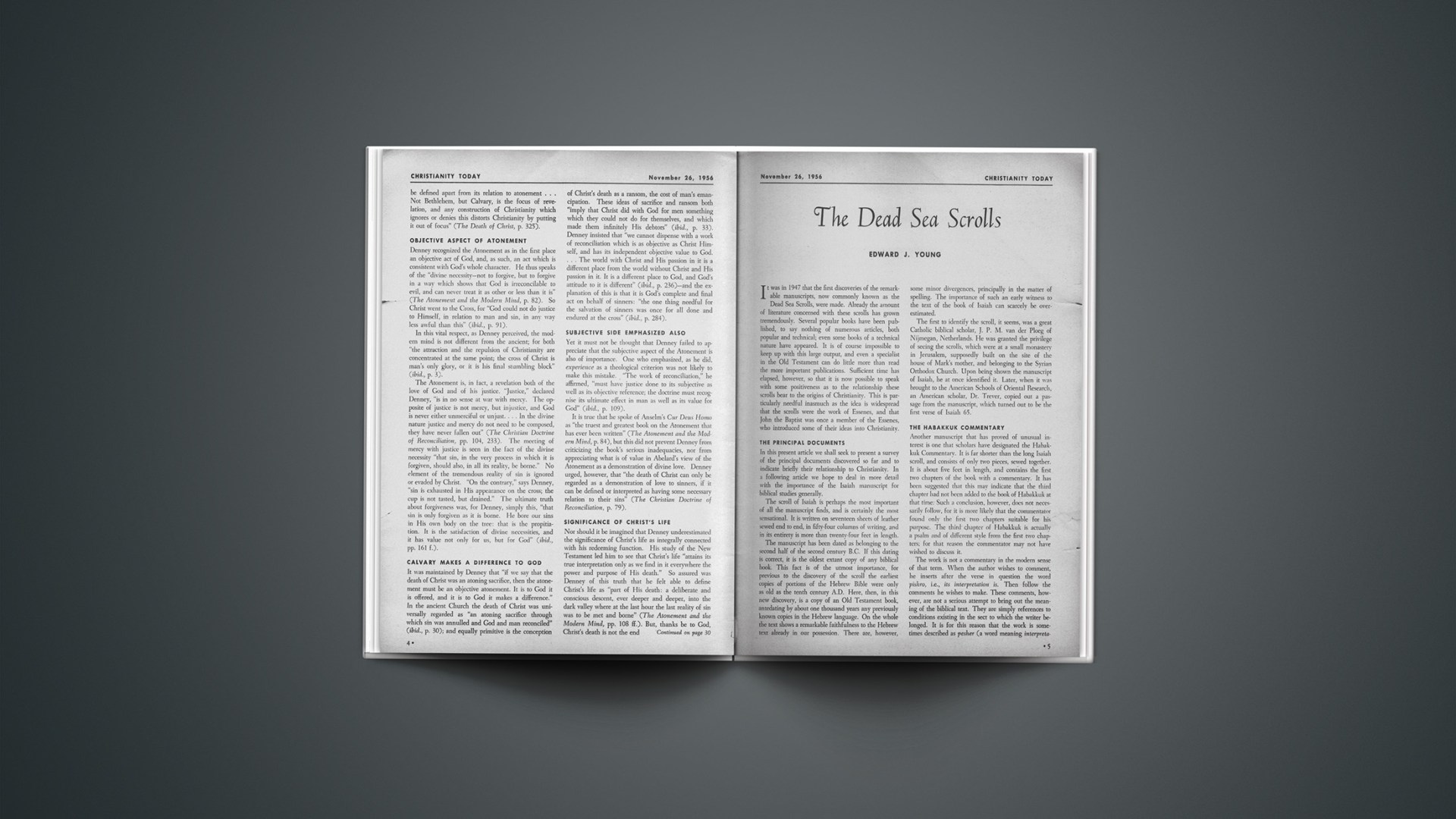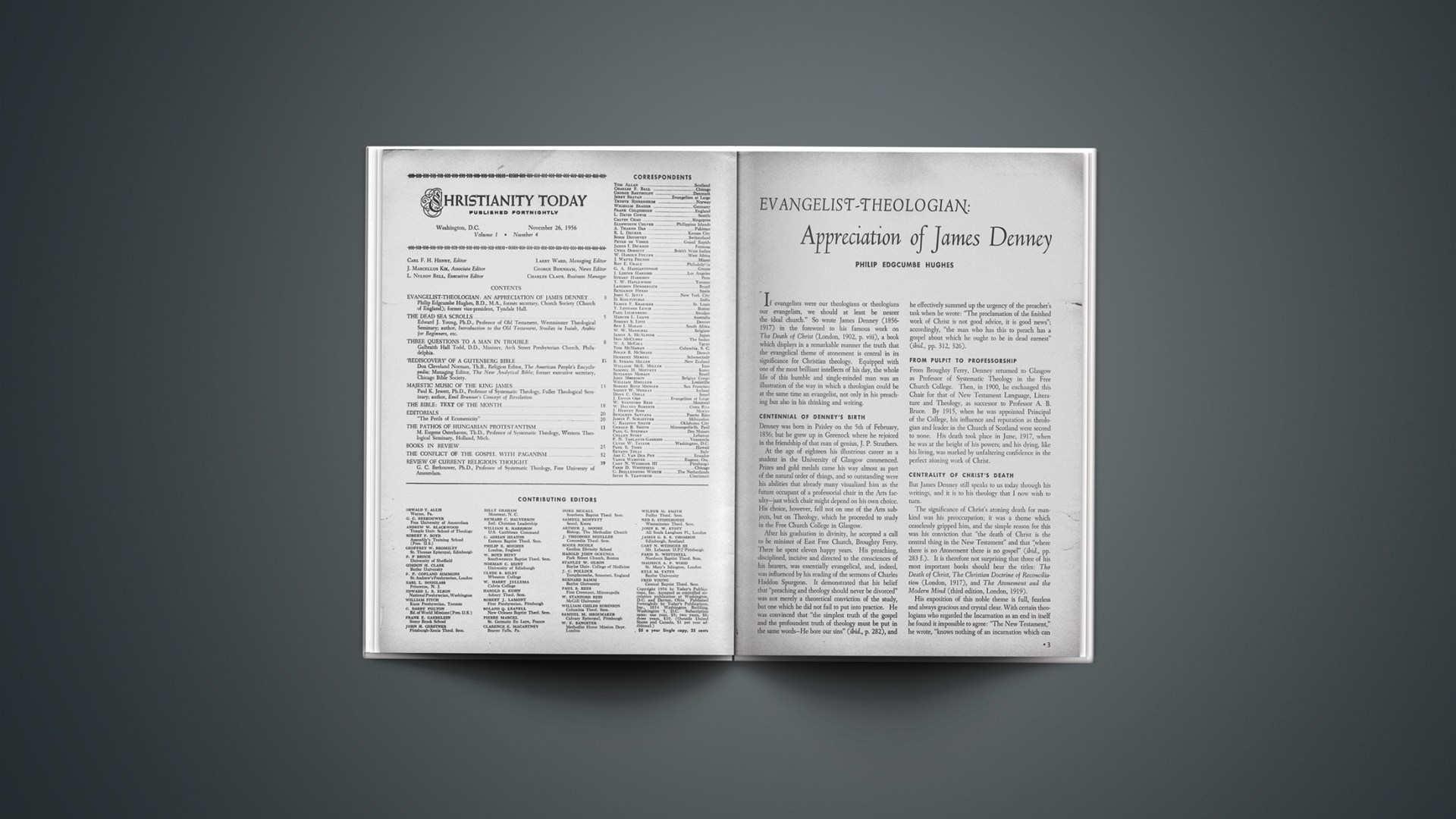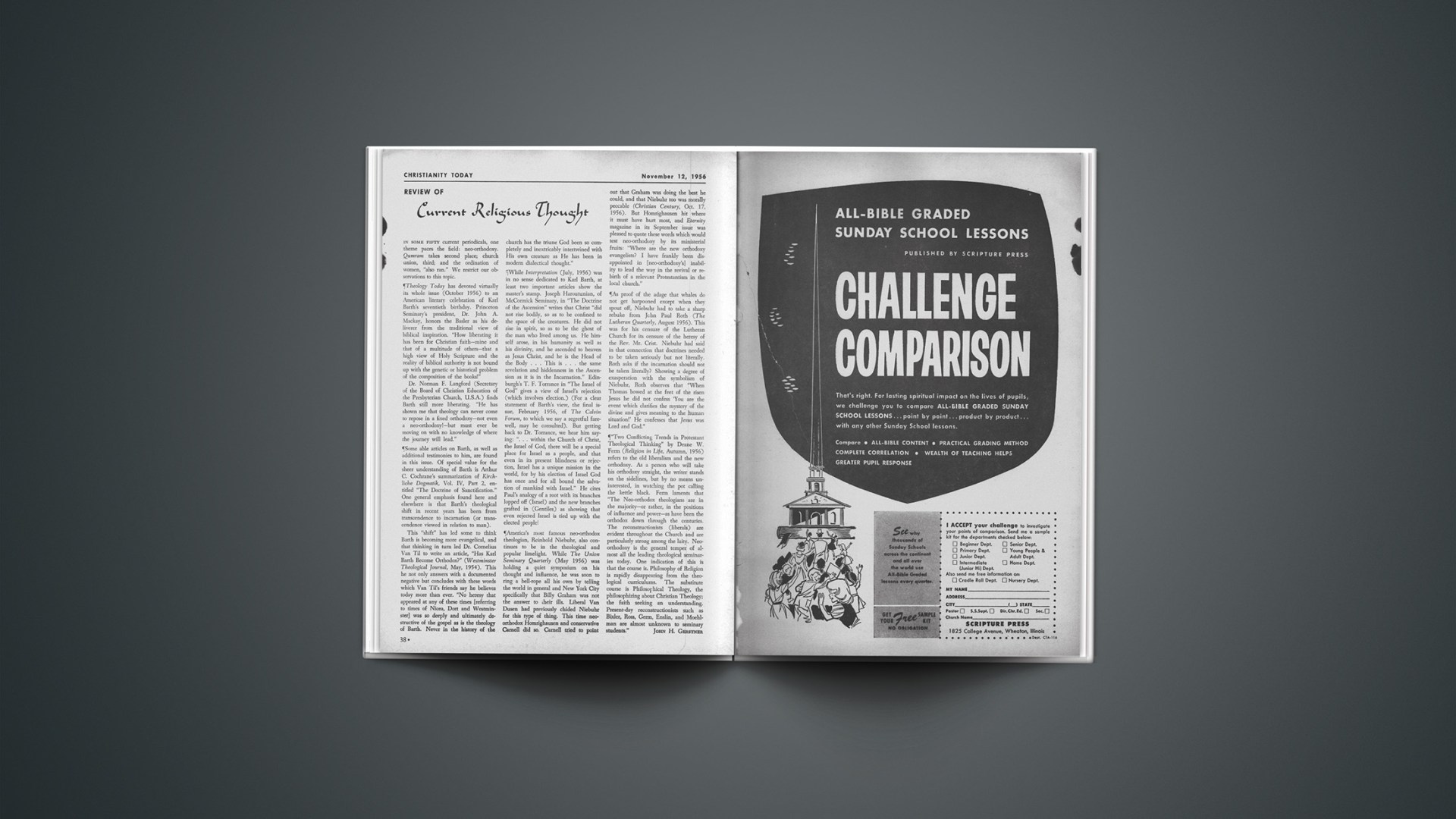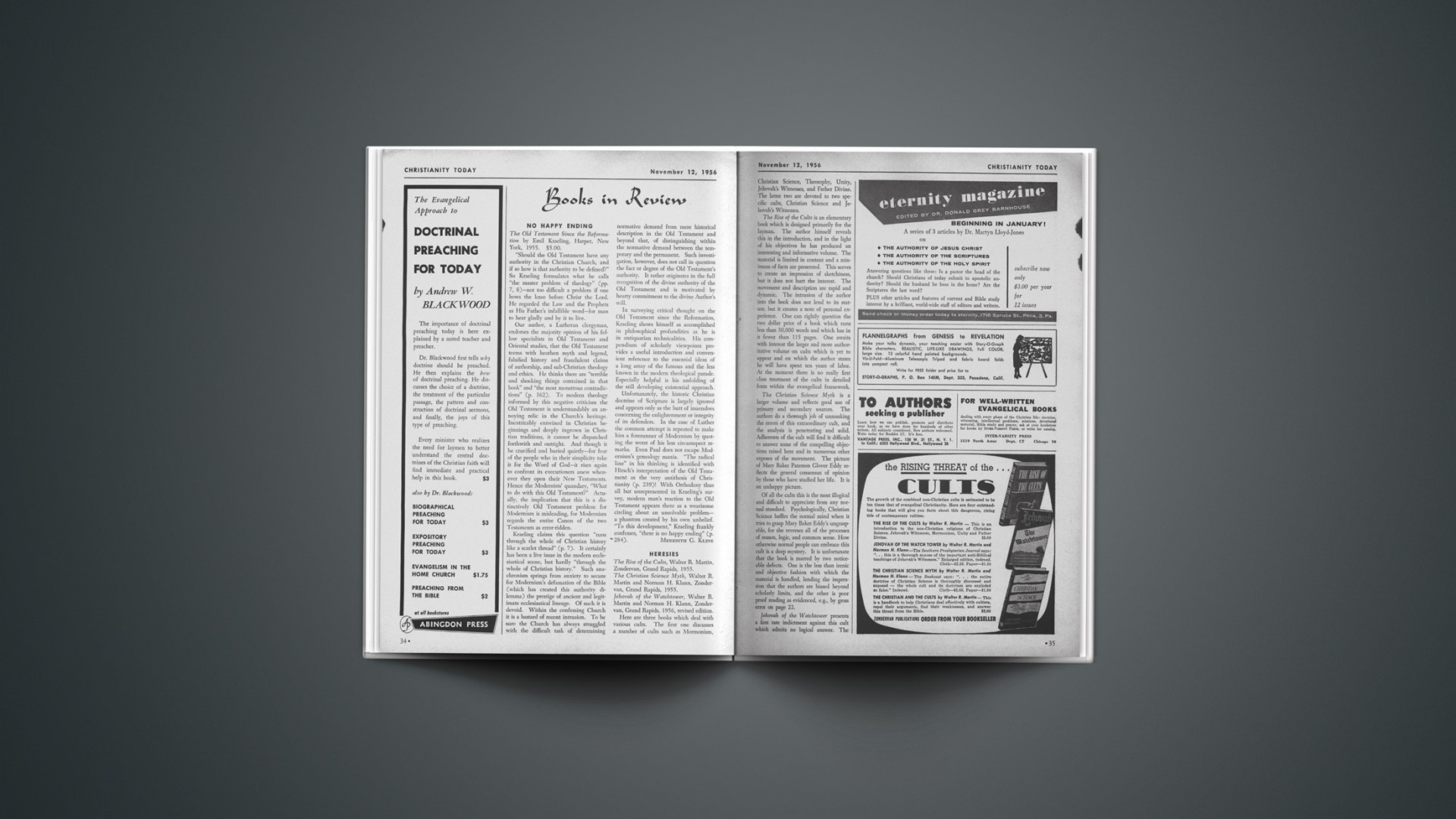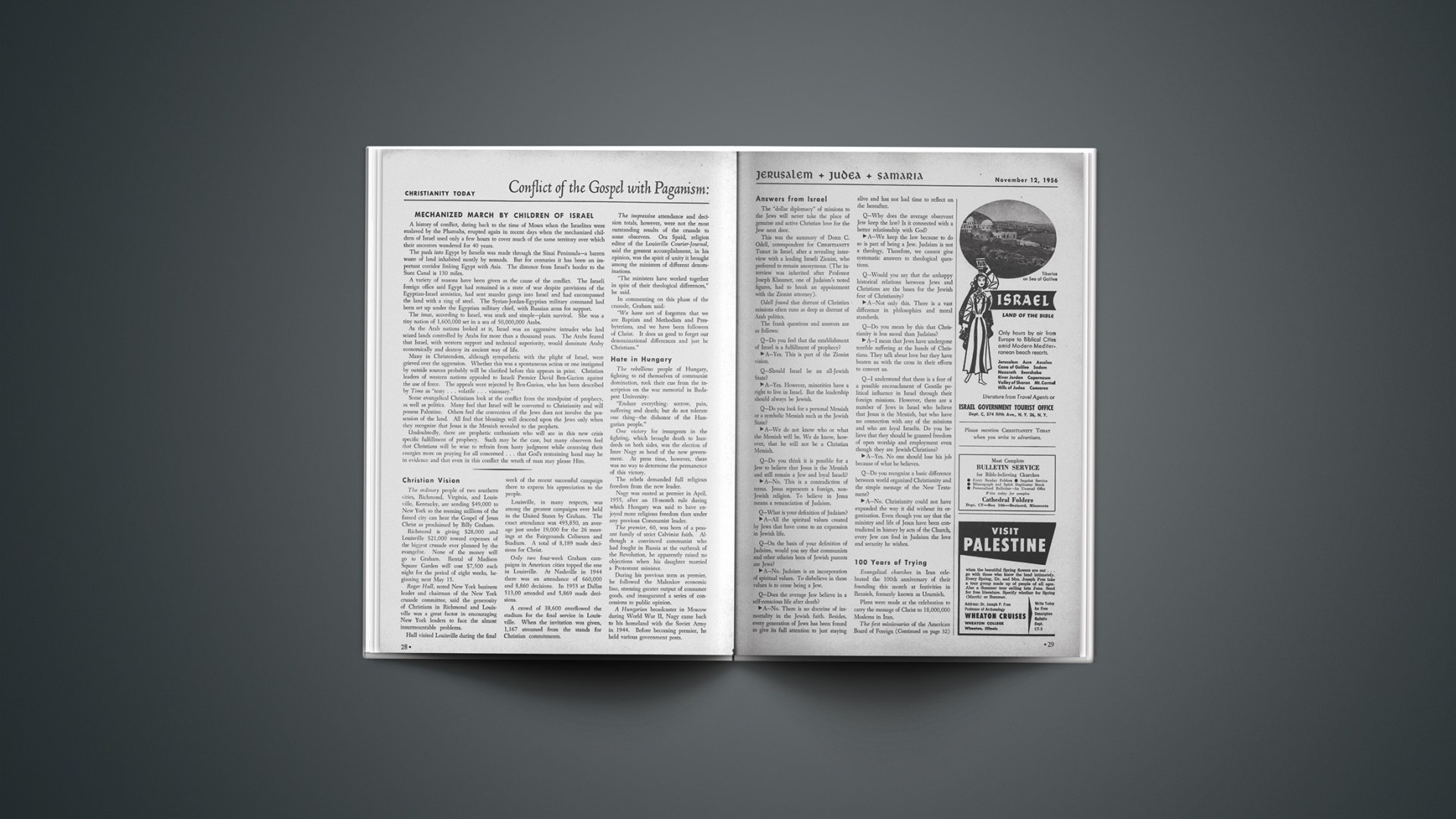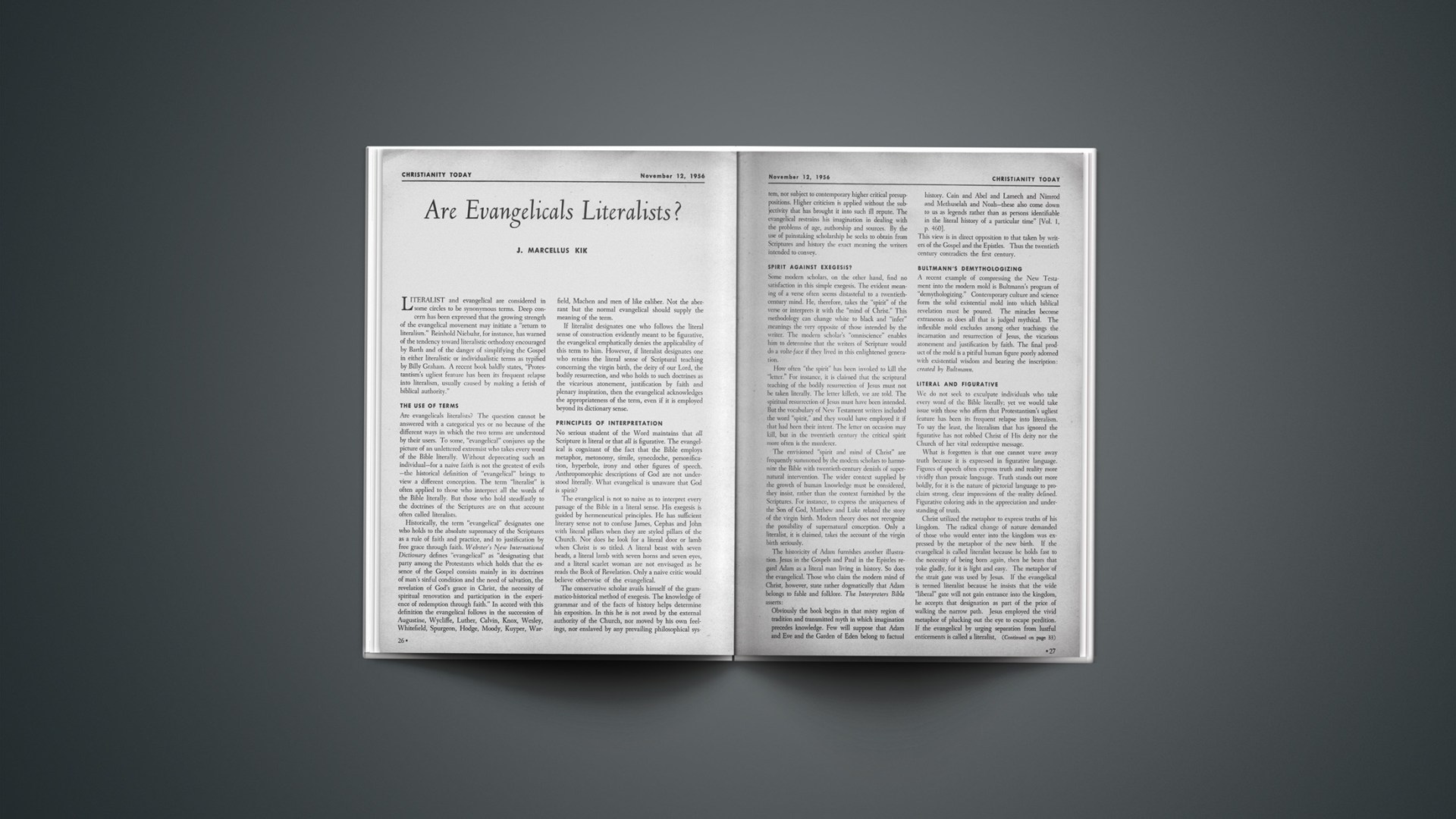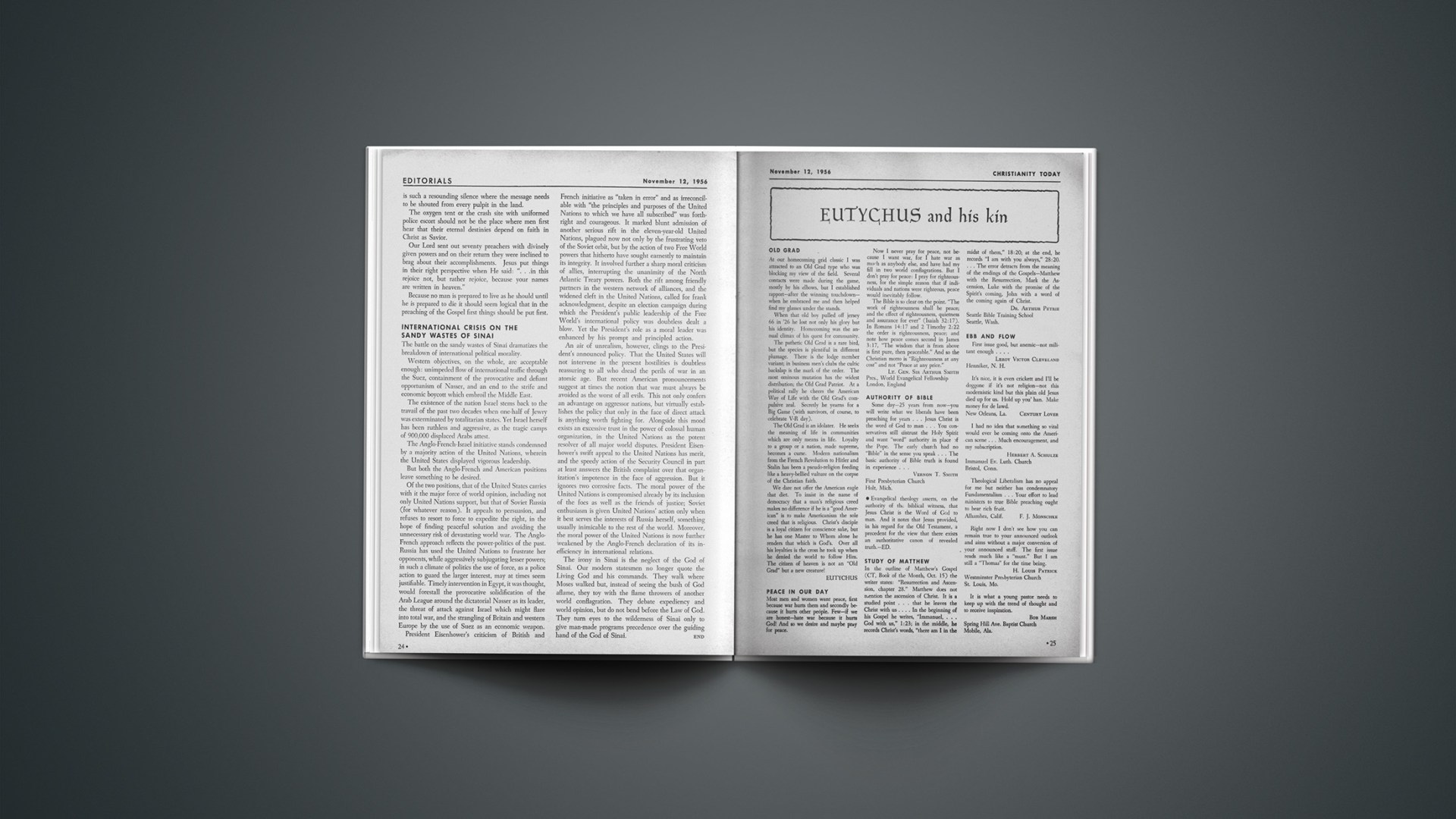On the eve of the release of the Revised Standard Version, Lowell Thomas, eminent news commentator, read excerpts from the Prophet Isaiah in the King James version and added—prophetically—“Pretty hard to beat.” Time has confirmed his judgment. The older version, like “ol’ man river, he jus’ keeps rollin’ along.”
It is easy to answer that the masses are prejudiced in favor of the old and suspicious of the new. But the King James itself had to begin as a lowly new version, pelted with charges of “bad theology, bad scholarship, and bad English.” It appeared without trumpet blast or public proclamation; it waged a running battle with the Geneva Bible for half a century and in this time completely took the field on the strength of its superior merit alone. In contrast to this the American revisers combined the advantage of organized sponsorship in high ecclesiastical places with access to a more accurate critical text, better scholarly equipment to understand Greek and Hebrew, and the lesson of the American Standard Version, “strong in Greek, weak in English.” And yet for all this, the King James, Gulliver-like, with its Lilliputian burden of colons and commas, verse and chapter divisions, is walking off with the victory. Why is this so? One reason that overshadows all others, it would seem, is the vastly superior literary quality of the older version. The King James is a work of art, the Revised Standard a compendium of scholarship; the one is literature, the other reading material.
To many, the element of literary excellence may seem inconsequential. Was not the New Testament written in vernacular Greek? Is not the Bible the book of the masses, and what do common people care about poetry? Anyway, our concern should be with the content of revealed truth, not its literary form.
Unconvincing Plea
I think these arguments are specious. It is true that the Greek of the New Testament is common Greek and in many of the books destitute of literary embellishment. But why should we not rejoice in the fact that the Bible in our mother tongue excels the original as literature? If the New Testament was written in the silver age of Greek and the King James in the golden age of English, is it not all Providence? The apostolic Christians worshipped in crypts and sand pits. Should we then tear down our cathedrals and seal up our organs?
Although it is a most significant feature of our Protestant heritage that the Bible is the book of the common man, to suppose that he is so circumscribed by the mundane realm of factual existence that he never breathes the rare atmosphere of poetry is an error as egregious as it is common. As Louis Untermeyer once observed, in A Treasury of Great Poems, we cannot escape poetry. To call an orange Sunkist, to name a melon Honeydew, capitalizes the power of poetry for the man in the street.
True, accuracy of thought is of paramount importance, yet we should never forget that men feel as well as understand, and what they understand with feeling they understand best. Here the incomparable literary quality of the King James, the music mingled with the meaning, is without a rival in its evocative power. The multitudes who never give a serious moment to literary analysis hear the majestic music of the King James as surely as the scholar—more surely than some Hebrew and Greek scholars.
How out of touch some scholars can be with this dimension is shown in the way the revisers translated Paul’s hymn to love (1 Corinthians 13). Love is the most beautiful thing in all the world, and with unerring literary instinct the King James translators have convinced us of this by giving us a supremely beautiful translation of this passage. The revisers, on the other hand, have left it a literary shambles. The same may be said of the unbelievable freedom with which they have handled the Psalter. Recognized as the peak of sacred poetry, with language exquisitely rich and resonant, the Psalter has not only been altered but ruined. In the King James we have poetry printed, unfortunately, as prose; but in the R.S.V. we have prose printed as poetry. Says Dorothy Thompson (“The Old Bible and the New,” Ladies’ Home Journal, March, 1953):
I have tried to read the new Bible with an open mind, and without prejudice, indeed with humility and with respect for so great an effort … But I am compelled to say that I find the new text inferior on nearly every page to the one it seeks to supplant and for reasons that I think I can define. It is weaker, less vivid, defective in imagery, less beautiful and less inspired. And I, at least, do not find it easier to understand.
But someone may still persist that the King James, beautiful as it is, is absolutely wrong in many places. This is undoubtedly true. The finest gems have flaws and there may be sand in the marble of the Parthenon. But shall we tear down the whole edifice for the sake of a few stones? This procedure becomes highly impracticable when we consider that those who have the wit to raze the old lack the genius to remake it.
But someone else will say that, though the King James is not hopelessly corrupt, it is fast becoming archaic. Since language is constantly changing, it is only a matter of time till the venerable version of our fathers takes its place on the shelf with Chaucer. Now this may happen, but if it does no one but the devil can contemplate it with glee. Our King James Bible is not a dispensable luxury of our English Protestant heritage. It is rather a part of us; it has permeated our culture in warp and woof; it is fused with our literature, our liturgy, our hymnody. Our situation is quite different in this respect from that of our Roman Catholic neighbors. All that Rome had to do to replace the Douay New Testament in 1941 was to announce its successor, an unwitting testimony to the negligible place of the Bible in the piety of its devotees. As a commonwealth changes the color of its automobile plates, so they changed their Bible. But fortunately we as Protestants have not the machinery to expedite such a change, nor is the biblical orientation of our piety so superficial that it can easily sustain such a macromutation.
Role Of New Version
Why then labor to bring new versions to the birth? What do we gain but an overpopulation of inferior species? The private modern-speech translations of individual scholars are most stimulating and edifying (e.g., Phillips’ Letters to Young Churches), but we have nothing to gain and everything to lose by multiplying versions, which claim the official sanction of the church as a whole. The first effort of 1886 and 1901 split the British and American churches and, had it succeeded, would have given the English-speaking church two vastly inferior Bibles in the place of one good one. And now with the R.S.V. we have in the American church three Bibles, even as the medieval church had three pontiffs during the Great Schism. If we multiply our Bibles as we have multiplied our denominations, we will only confuse people the more and psychologically, if not theoretically, undermine their sense of the authority of Scripture. The common man always speaks in the singular of THE BIBLE, which is no mere phonetic accident, but an unerring instinct. Variety is not always the spice of life. We need several Bibles about as much as the Roman Church needs several popes. If we are serious about ecumenicity, we would do well to preserve the one thing we really have in common, i.e., our King James Bible. We therefore conclude that the King James ought not, even as it cannot, be replaced.
But the question still remains, what to do. Even if we grant that our age has not the creative powers to produce a worthy successor to the version inherited from our fathers; even if we say with all conviction, like the man who tasted old wine and refused the new, that we are standing by our King James Bible; will our King James stand by us? Will not time, whose art turns all things to dust, take it from us as surely as the weather will carry the mountains into the sea? Though as literature it will abide forever, from the perspective of the centuries can it endure as a vehicle of revelation for the common man?
We have come to a point where one must speak as an expert, or risk the role of a dilettante. But not to speak at all would end the discussion, as some modern plays end, leaving the frustrated spectator to supply his own denouement. Let us then address ourselves further to this question.
Theoretically it is true that no version can endure forever, but this is no reason for sitting on our hands. The fate of the King James a million years from now has no more bearing for us than the second law of thermodynamics for the current price of real estate. Had we expended half the scholarly energy in saving the King James that we have spent in efforts to supplant it, we should have come a long way on the path to a solution.
The first and most obvious thing that needs to be done is to modernize the physical form of our received Bible. It is common knowledge that the King James has undergone such revision in the past. In 1613, just two years after the original printing, a second edition appeared with more than four hundred variations. Other revisions occurred in 1629 and 1638 and in 1762. In 1769 the Oxford edition appeared with much modernization of spelling and punctuation. It is almost unbelievable, but true, that this is the current form of the text. In nearly two hundred years we have hardly converted a colon to a semicolon. Why is this? Do we believe that God wrote the King James with his finger on tables of stone? If we can give up inspired Hebrew vowel points and Holy Ghost Greek, must we canonize the commas of the King James? Why could not an ecumenical committee of experts, working jointly in England and America, solve this problem to the satisfaction of all? If a King James version, word for word as it now appears, were to be given a new form to this limited extent, it surely seems that the archaic punctuation would surrender its dominance to the new.
Having leaped this hurdle, the next step might be to cast the poetry as poetry and the prose as prose, giving the later the form of the modern paragraph rather than the present chapter and verse arrangement. Even the most rabid defenders of the King James admit that our chapter and verse divisions are not inspired.
Though long overdue, the changing of actual words should wait till these less controversial alterations have generally ingratiated themselves with the people as a whole. Perhaps marginal notes could be used to prepare readers gradually where usage is becoming archaic or the text is quite different from the best MSS evidence. In any event, when the changes are made, the task should be approached as one for experts in English primarily and only secondarily for Hebrew and Greek specialists. In other words, if in the mind of those best able to judge, a given usage has become archaic, then let the experts in English choose a new word or phrase, in consultation with those who know best what the Hebrew and Greek actually says. Under no circumstances should many such changes be made in a given generation, and rarely, if ever, should a change be made in those areas affecting received literary parlance or the common idiom of personal piety and public worship. Every literate person knows, for example, what the expression “God forbid” means. There is, therefore, no excuse for changing this to “let it not be” or “by no means.” The same goes for “plow with my heifer,” “skin of my teeth,” “whited sepulchre,” and the like. As for the idiom of personal and public piety, the decision of the American revisers of 1901 to substitute “Jehovah” for “Lord” was a blunder for which there can be no other word than crude. To delete from the Bible the most common name of deity in our language and insert “Jehovah” was enough, in itself, to doom their effort. The recent revisers had the good sense to go back to “Lord” in the Old Testament. One could wish that they had restored the Lord’s Prayer in Matthew 6 to its common form. We are pleading, then, for principles of translation, that not even the architects of the R.S.V. have been able altogether to ignore. The advantages of a procedure along the lines outlined above are obvious. First, by pursuing such a course we would, first of all, preserve our King James version, the greatest version of the Bible ever achieved. In the second place, we would bequeath it to our children in a form that would enable them to hear the Word of God in language not only meaningful but magnificent.
Paul K. Jewett, Ph.D., is Professor of Systematic Theology at Fuller Theological Seminary and author of Emil Brunner’s Concept of Revelation.



